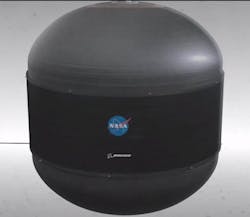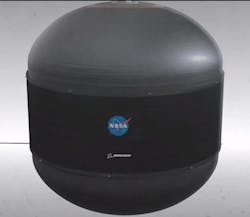NASA tests composite cryogenic fuel tank, considered a major space technology development
WASHINGTON, 4 July 2013.NASA engineers tested a pressurized, large cryogenic propellant tank, which is made of composite materials and designed to enable the next generation of rockets and spacecraft needed for space exploration.
"Game changing is about developing transformative technologies that enable new missions and new capabilities," says Stephen Gaddis, the program manager for the Game Changing Development Program at NASA's Langley Research Center in Hampton, Va. "Technological advances like the cryogenic tank can ripple throughout the aerospace industry and change the way we do business."
Cryogenic propellants are gasses chilled to subfreezing temperatures and condensed to form highly combustible liquids, providing high-energy propulsion solutions. Liquid oxygen and liquid hydrogen cryogenic propellants have been traditionally used to provide the enormous thrust needed for large rockets and NASA's space shuttle. In the past, propellant tanks have been fabricated out of metals.
"These successful tests mark an important milestone on the path to demonstrating the composite cryogenic tanks needed to accomplish our next generation of deep space missions," explins Michael Gazarik, NASA's associate administrator for space technology at NASA Headquarters in Washington. "This investment in game-changing space technology will help enable NASA's exploration of deep space while directly benefiting American industrial capability in the manufacturing and use of composites."
NASA engineers, in testing a composite cryogenic fuel tank, have achieved a major space technology development milestone. The composite tank, having a diameter of nearly 8 feet (2.4 meters), was tested at NASA's Marshall Space Flight Center in Huntsville, Ala. This technology is critical to future, long-term human exploration missions beyond low-Earth orbit, scientists say. Composite tanks may significantly reduce the cost and weight for launch vehicles and other space missions.
Switching from metallic to composite construction holds the potential to dramatically increase the performance capabilities of future space systems through a dramatic reduction in weight. A potential initial target application for the composite technology is an upgrade to the upper stage of NASA's Space Launch System heavy-lift rocket.
Built by Boeing at their Tukwila, Wash. facility, the tank arrived at NASA in late 2012. Engineers insulated and inspected the tank, then put it through a series of pressurized tests to measure its ability to contain liquid hydrogen at extremely cold temperatures. The tank was cooled down to -423 degrees Fahrenheit and underwent 20 pressure cycles as engineers changed the pressure up to 135 psi.
"This testing experience with the smaller tank is helping us perfect manufacturing and test plans for a much larger tank," says John Vickers, the cryogenic tank project manager at Marshall. "The 5.5-meter (18-foot) tank will be one of the largest composite propellant tanks ever built and will incorporate design features and manufacturing processes applicable to an 8.4-meter (27.5-foot) tank, the size of metal tanks found in today's large launch vehicles."
The NASA and Boeing team are in the process of manufacturing the 18 foot (5.5 meter)-diameter composite tank that also will be tested at Marshall next year.
Composite tank joints, especially bolted joints, have been a particularly troubling area prone to leaks in the past. Boeing and its partner, Janicki Industries of Sedro-Woolley, Wash., developed novel tooling to eliminate the need for heavy joints.
NASA's cryogenic storage tank research is part of the agency's Space Technology Mission Directorate, which is innovating, developing, testing, and flying hardware for use in NASA's future missions.

